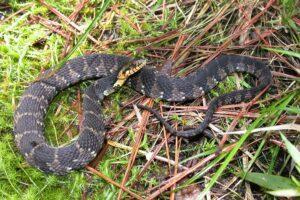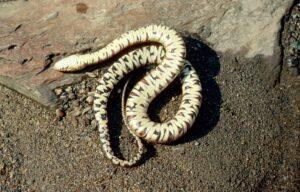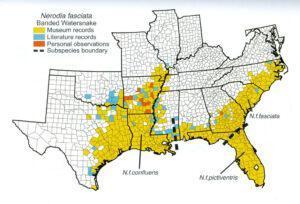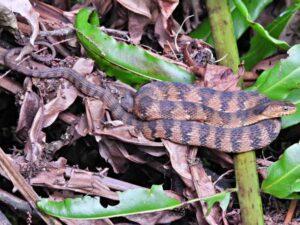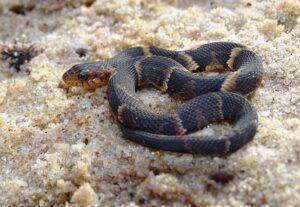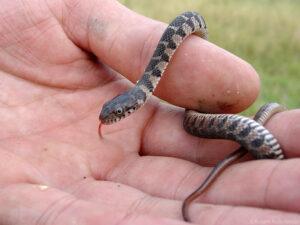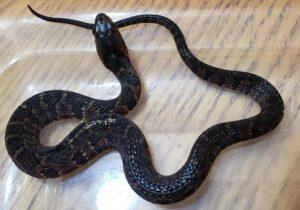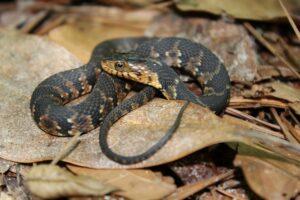The banded water snake, also known as the southern water snake, is a primarily aquatic colubrid native to the midwestern and southeastern US. It is of medium size and has a fairly heavy body. The snakes get darker with age, and the adults get killed due to their resemblance to the venomous cottonmouths.
Scientific Classifications
- Suborder:Serpentes
- Family:Colubridae
- Genus:Nerodia
- Species:N. fasciata
Conservation Status
Subspecies
This snake has three recognized subspecies.
- Broad-banded water snake (Nerodia fasciata confluens)
- Florida banded water snake (Nerodia fasciata pictiventris)
- Southern water snake (Nerodia fasciata fasciata)
Description
Size
The adult southern water snake measures 24-42 inches (61-107 cm) in length. Its average body mass is 16.38 oz (464.3 g)
Color and Appearance
The colubrid is typically greenish-gray, gray, or brown with a dark crossband pattern. Some individuals are so dark in color that their markings can be barely seen. The belly is usually off-white to white. Another identifying trait is a dark stripe stretching from the eye to the angle of the jaw. It has a flat head and exhibits sexual dimorphism, with the female being longer and heavier than the male.
Are They Dangerous to Humans
These snakes are quick to flee if they sense danger. But if cornered or captured, they can act pretty defensive and don’t hesitate to inflict a painful non-venomous bite. When irritated, they release a foul-smelling musk to resist their attacker.
Banded Water Snakes at a Glance
Lifespan
The southern water snake lives for about 8 years in the wild and 3 years in captivity.
Predators
Its main enemies are birds of prey such as the great blue heron, semi-aquatic creatures such as the alligator, and other bigger snakes.
Diet
It eats a variety of prey like frogs, fish, salamanders, and tadpoles that they forage using their senses of smell and sight. It catches and swallows them whole without constricting or subduing them. Juveniles mainly eat fish as eating other kinds of prey like frogs is challenging for them as their jaws don’t open much wide.
Reproduction
Viviparous (gives birth to live young)
The babies are born in late July or August, with the brood size varying between 15 and 20. They are 8-9.5 inches (20-24 cm) in length. The species can mate with the common watersnake on rare occasions, but there are not enough traits to identify the hybrids. DNA analysis is required to prove the union.
Similar Species
Cottonmouth or Water Moccasin
The venomous cottonmouth or water moccasin, Agkistrodon piscivorus, has a big, blocky head that is distinctly wider than its neck. The banded water snake has an elongated, slender head that smoothly blends into the body with no prominent neck.
Copperhead
The venomous copperhead, Agkistrodon contortrix, has a triangular head, while the southern water snake has a narrower, straight, and slightly rounded head that is in line with its body. Plus, the bands on the latter are broadest on top and have a symmetrical appearance, while those on the copperhead are narrowest on top with the pattern resembling an hourglass.
Care Sheet
Size of the Enclosure: The length of the vivarium should not exceed 2/3rd of the size of the adult snake. So an enclosure of a minimum of 18 inches (45 cm) length can be used for housing a male, and the same should be 24-30 inches (61-76.2 cm) for a female.
Humidity: The ideal humidity for the pet setup is 60%, and it should not fall below 40%. A larger than average-sized water bowl should be placed in the middle of the tank.
Substrate: Coir, orchid bark, or a mixture of both is a suitable substrate. It should never be water-logged.
Feeding: Adults can be fed defrosted mice while hatchlings and very young snakes can be given pinkies.
Source
herpsofnc.org, floridamuseum.ufl.edu, live.staticflickr.com, deviantart.com, media.istockphoto.com, louisianaherps.com, floridamuseum.ufl.edu, wixmp.com

